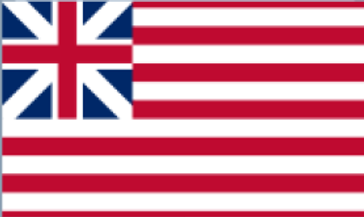
The History of the American Flag
The United States national flag was created after the Second Continental Congress approved the Flag Resolution on June 14th, 1777 by stating: “the flag of the thirteen United States be thirteen stripes, alternate red and white; that the union be thirteen stars, white in a blue field, representing a new constellation.”
Red for valor and hardiness, white for purity, and innocence and blue for vigilance, perseverance and justice. Since its creation, the design has been officially modified twenty-seven times.

Concept and historical information for this handout was provided by Foundation Intern, Marco Del Bene, Senior at Pace University in New York. The campaign aligns perfectly with the Foundation's mission to educate on the lessons of citizenship, sacrifice, and service to one's country. The Bob Feller Act of Valor Award foundation is a 501(c3) organization.

The Red Ensign Flag
The United States flag was based on the flag flown by British merchant or passenger ships in 1707.

The Grand Union Flag (1775)
The first flag was created during the American Revolutionary War (1775-1783) for the Continental Army and Navy. A possible theory of the added “white stripes” was inspired by the coat of arms of George Washington’s family in England prior to their settlement in the Colony of Virginia during the 17th century.
.png)
The First Official Stars and
Stripes Flag (1777)
After signing the Declaration of Independence in 1776, Francis Hopkinson, Founding Father and delegate of the Second Continental Congress from New Jersey, designed two versions of flags for the United States and the Navy. His Navy design was chosen. It contained a red background, six white stripes and thirteen six pointed stars.

The Elizabeth “Betsy” Ross Thirteen Star Flag
Elizabeth Ross, an upholster from New Jersey, presented a new national flag to General George Washington of the Continental Army and congressional committee members: Robert Morris and George Ross. She convinced Washington to change the six pointed star shape to five, which allowed for faster cutting and sewing.

The Star-Spangled Banner (1794)
When the states of Vermont (1791) and Kentucky (1792) entered the Union, two additional stars and stripes were added to the flag. During the War of 1812, the American victory at the Battle of Baltimore (1814) and the Star-Spangled Banner flag inspired Francis Scott Key to write the poem “Defense of Fort McHenry” which later became the lyrics to the national anthem in 1931.

The Flag Act (1818)
The Flag Act of 1818 changed the flag to have twenty stars. It was designed by U.S. Navy captain Samuel C. Reid. A new star would be added whenever a new state was admitted into the Union but the number of stripes would be reduced to thirteen in order to honor the original colonies.

Twenty-Nine Star Diamond Pattern Flag (1846)
Iowa was admitted into the union as the twenty-ninth state under President James Polk in 1846. From the 19th century until the adoption of the Forty-Eight Star flag in 1912, there was no official arrangement of the stars in the canton whenever a new state was added into the Union. This led to many different patterns either arranged in a star, diamond, alternate or circle designed by the U.S. Army or Navy.

Thirty-Three Star Alternate Pattern Flag (1859)
After the Louisiana Purchase in 1803, Captain Meriwether Lewis and Lieutenant William Clark led a military expedition to the Pacific Northwest from 1804 to 1806. During the 1830s, pioneers travelled and settled into the region. Oregon was admitted into the Union as the thirty-third state in 1859 under President James Buchanan.

Thirty-Four Star Circle Pattern Flag (1861)
The Kansas–Nebraska Act of 1854 created the territories of Kansas and Nebraska. It was drafted by Senator Stephen Douglas and passed by the US Congress. In 1861, Kansas was admitted into the Union as the thirty-fourth state. In 1867, Nebraska became the thirty-seventh state to join the Union under President Andrew Johnson.
.png)
Forty-Nine Star Flag (1959)
The Forty-Eight Star flag had been in effect from 1912-1959. In 1959, Alaska was admitted as the Forty-Ninth state under Executive Order 10798 issued by President Dwight D. Eisenhower.
.jpg)
Fifty Star Flag (1960)
Hawaii was the last state to join the Union. High school student Robert G. Heft’s design was chosen as our nation's flag by U.S. President Eisenhower out of 1,500 others.

The Bob Feller Act of Valor Award Foundation wishes to thank all of our interns for their passionate support of the Foundation and the projects we execute to accomplish our mission. Since 2019, the Bob Feller Act of Valor Internship program has provided more than 100 students an opportunity to work with professionals in sports, business, and the military. Our career focussed mentoring program embraces practical skills, workplace experience and greater knowledge in the areas of Sports Management, Marketing and Business.
To learn more about the Bob Feller Act of Valor Internship program or to make a donation, please click here
